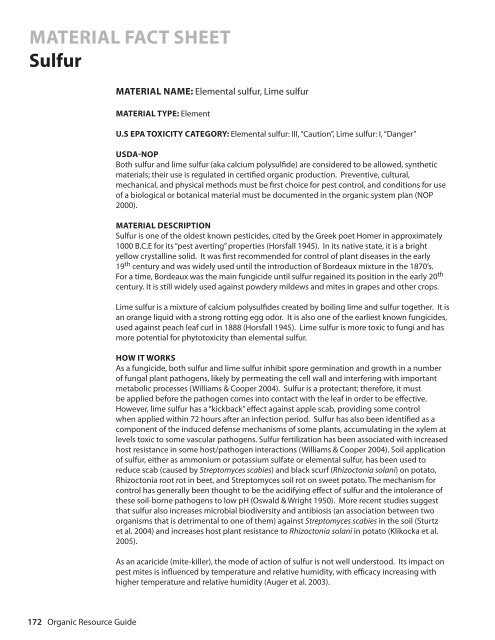Resource Guide for Organic Insect and Disease ... - Cornell University
Resource Guide for Organic Insect and Disease ... - Cornell University
Resource Guide for Organic Insect and Disease ... - Cornell University
Create successful ePaper yourself
Turn your PDF publications into a flip-book with our unique Google optimized e-Paper software.
MATERIAL FACT SHEET<br />
Sulfur<br />
MATERIAL NAME: Elemental sulfur, Lime sulfur<br />
MATERIAL TYPE: Element<br />
U.S EPA TOXICITY CATEGORY: Elemental sulfur: III, “Caution”, Lime sulfur: I, “Danger”<br />
USDA-NOP<br />
Both sulfur <strong>and</strong> lime sulfur (aka calcium polysulfide) are considered to be allowed, synthetic<br />
materials; their use is regulated in certified organic production. Preventive, cultural,<br />
mechanical, <strong>and</strong> physical methods must be first choice <strong>for</strong> pest control, <strong>and</strong> conditions <strong>for</strong> use<br />
of a biological or botanical material must be documented in the organic system plan (NOP<br />
2000).<br />
MATERIAL DESCRIPTION<br />
Sulfur is one of the oldest known pesticides, cited by the Greek poet Homer in approximately<br />
1000 B.C.E <strong>for</strong> its “pest averting” properties (Horsfall 1945). In its native state, it is a bright<br />
yellow crystalline solid. It was first recommended <strong>for</strong> control of plant diseases in the early<br />
19 th century <strong>and</strong> was widely used until the introduction of Bordeaux mixture in the 1870’s.<br />
For a time, Bordeaux was the main fungicide until sulfur regained its position in the early 20 th<br />
century. It is still widely used against powdery mildews <strong>and</strong> mites in grapes <strong>and</strong> other crops.<br />
Lime sulfur is a mixture of calcium polysulfides created by boiling lime <strong>and</strong> sulfur together. It is<br />
an orange liquid with a strong rotting egg odor. It is also one of the earliest known fungicides,<br />
used against peach leaf curl in 1888 (Horsfall 1945). Lime sulfur is more toxic to fungi <strong>and</strong> has<br />
more potential <strong>for</strong> phytotoxicity than elemental sulfur.<br />
HOW IT WORKS<br />
As a fungicide, both sulfur <strong>and</strong> lime sulfur inhibit spore germination <strong>and</strong> growth in a number<br />
of fungal plant pathogens, likely by permeating the cell wall <strong>and</strong> interfering with important<br />
metabolic processes (Williams & Cooper 2004). Sulfur is a protectant; there<strong>for</strong>e, it must<br />
be applied be<strong>for</strong>e the pathogen comes into contact with the leaf in order to be effective.<br />
However, lime sulfur has a “kickback” effect against apple scab, providing some control<br />
when applied within 72 hours after an infection period. Sulfur has also been identified as a<br />
component of the induced defense mechanisms of some plants, accumulating in the xylem at<br />
levels toxic to some vascular pathogens. Sulfur fertilization has been associated with increased<br />
host resistance in some host/pathogen interactions (Williams & Cooper 2004). Soil application<br />
of sulfur, either as ammonium or potassium sulfate or elemental sulfur, has been used to<br />
reduce scab (caused by Streptomyces scabies) <strong>and</strong> black scurf (Rhizoctonia solani) on potato,<br />
Rhizoctonia root rot in beet, <strong>and</strong> Streptomyces soil rot on sweet potato. The mechanism <strong>for</strong><br />
control has generally been thought to be the acidifying effect of sulfur <strong>and</strong> the intolerance of<br />
these soil-borne pathogens to low pH (Oswald & Wright 1950). More recent studies suggest<br />
that sulfur also increases microbial biodiversity <strong>and</strong> antibiosis (an association between two<br />
organisms that is detrimental to one of them) against Streptomyces scabies in the soil (Sturtz<br />
et al. 2004) <strong>and</strong> increases host plant resistance to Rhizoctonia solani in potato (Klikocka et al.<br />
2005).<br />
As an acaricide (mite-killer), the mode of action of sulfur is not well understood. Its impact on<br />
pest mites is influenced by temperature <strong>and</strong> relative humidity, with efficacy increasing with<br />
higher temperature <strong>and</strong> relative humidity (Auger et al. 2003).<br />
172 <strong>Organic</strong> <strong>Resource</strong> <strong>Guide</strong>







